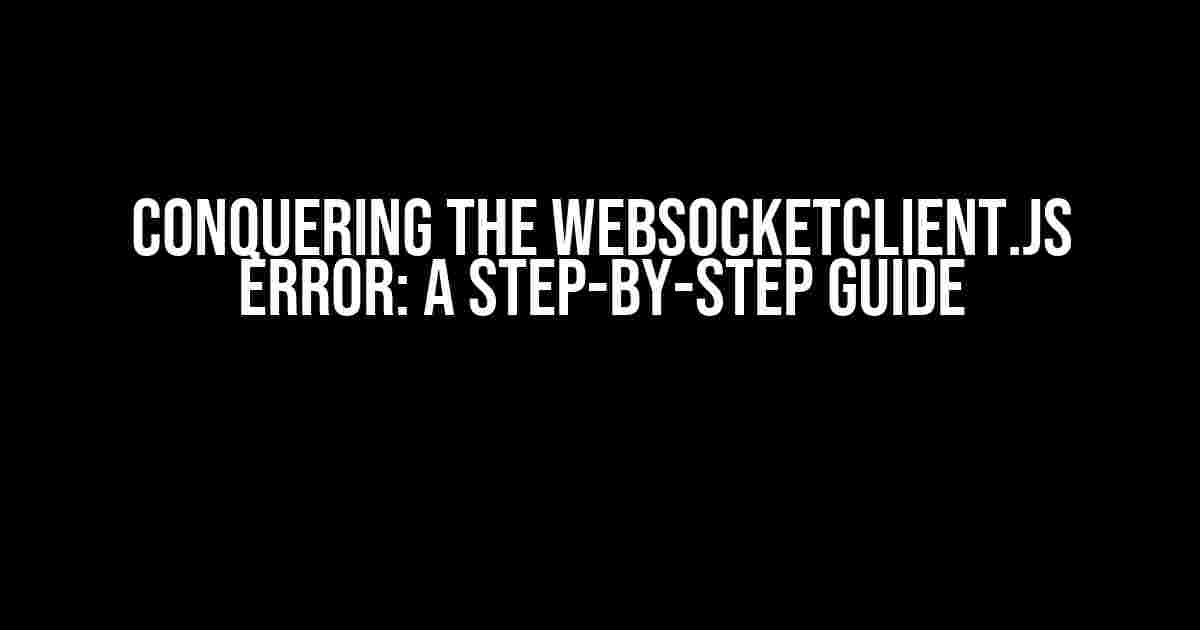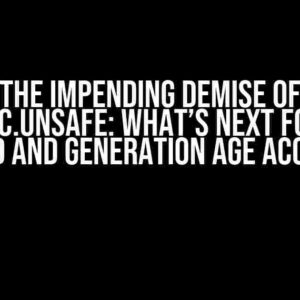WebSocketClient.js is an incredible tool for building real-time web applications, but it’s not uncommon to encounter errors that can leave you scratching your head. One of the most frustrating errors is the infamous “WebSocketClient.js:13 WebSocket connection to ‘ws://localhost:3000/ws’ failed:” error. But fear not, dear developer, for we’re about to embark on a journey to vanquish this error once and for all!
Understanding the Error
Before we dive into the solution, let’s take a closer look at the error message:
WebSocketClient.js:13 WebSocket connection to 'ws://localhost:3000/ws' failed:This error typically occurs when there’s an issue with the WebSocket connection. It might be due to a misconfigured server, incorrect WebSocket URL, or even a permissions problem. Don’t worry, we’ll cover all the possible causes and solutions in this article.
Prerequisites
Before we begin, make sure you have the following:
- Node.js installed on your machine (you can download it from the official Node.js website).
- WebSocketClient.js library installed in your project (you can install it using npm by running
npm install websocket-client). - A basic understanding of JavaScript and WebSocket concepts.
Causes of the Error
Now that we’ve got our prerequisites in check, let’s explore the possible causes of the error:
1. Incorrect WebSocket URL
One of the most common causes of this error is an incorrect WebSocket URL. Make sure you’re using the correct URL scheme (ws or wss) and that the URL is correctly formatted.
const wsUrl = 'ws://localhost:3000/ws'; // Correct URL2. Server Configuration Issues
Another possible cause is a misconfigured server. Check your server settings to ensure that WebSockets are enabled and that the WebSocket endpoint is correctly configured.
const express = require('express');
const app = express();
const server = require('http').createServer(app);
const wss = require('ws').Server({ server });
wss.on('connection', (ws) => {
console.log('Client connected');
ws.on('message', (message) => {
console.log(`Received message => ${message}`);
ws.send(`Server response => ${message}`);
});
});
server.listen(3000, () => {
console.log('Server started on port 3000');
});3. Permissions Issues
WebSocket connections may require special permissions, especially when working with localhost. Ensure that your WebSocket client has the necessary permissions to connect to the server.
const WebSocket = require('ws');
const ws = new WebSocket('ws://localhost:3000/ws', {
// Set the origin to allow connections from localhost
origin: 'http://localhost:3000',
});Solutions
Now that we’ve identified the possible causes, let’s dive into the solutions:
1. Verify the WebSocket URL
Double-check your WebSocket URL to ensure it’s correct. Try using a WebSocket testing tool like WebSocket Echo Test to verify the connection.
const wsUrl = 'ws://localhost:3000/ws';
const ws = new WebSocket(wsUrl);
ws.on('open', () => {
console.log('WebSocket connection established');
ws.send('Hello, server!');
});
ws.on('message', (message) => {
console.log(`Received message => ${message}`);
});2. Configure the Server Correctly
Make sure your server is configured to support WebSockets. If you’re using a framework like Express.js, ensure that you’re using the correct middleware to enable WebSockets.
const express = require('express');
const app = express();
const server = require('http').createServer(app);
const wss = require('ws').Server({ server });
wss.on('connection', (ws) => {
console.log('Client connected');
ws.on('message', (message) => {
console.log(`Received message => ${message}`);
ws.send(`Server response => ${message}`);
});
});
server.listen(3000, () => {
console.log('Server started on port 3000');
});3. Set Correct Permissions
Ensure that your WebSocket client has the necessary permissions to connect to the server. If you’re using localhost, set the origin correctly to allow connections.
const WebSocket = require('ws');
const ws = new WebSocket('ws://localhost:3000/ws', {
origin: 'http://localhost:3000',
});Best Practices
To avoid running into this error in the future, follow these best practices:
| Best Practice | Description |
|---|---|
| Verify WebSocket URL | Double-check your WebSocket URL to ensure it’s correct and working. |
| Configure Server Correctly | Ensure that your server is configured to support WebSockets and that the WebSocket endpoint is correctly configured. |
| Set Correct Permissions | Set the correct permissions for your WebSocket client to connect to the server. |
| Use a WebSocket Testing Tool | Use a WebSocket testing tool like WebSocket Echo Test to verify the connection and identify issues. |
Conclusion
Vanquishing the “WebSocketClient.js:13 WebSocket connection to ‘ws://localhost:3000/ws’ failed:” error is a breeze when you know what to look for. By understanding the causes of the error, verifying the WebSocket URL, configuring the server correctly, and setting correct permissions, you’ll be well on your way to building real-time web applications with WebSocketClient.js. Remember to follow the best practices outlined in this article to avoid running into this error in the future.
Now, go forth and conquer the world of real-time web development with WebSocketClient.js!
Happy coding!
Here are 5 Questions and Answers about “WebSocketClient.js:13 WebSocket connection to ‘ws://localhost:3000/ws’ failed:” in HTML format:
Frequently Asked Question
Having trouble with WebSocket connections? You’re not alone! Here are some frequently asked questions to help you troubleshoot the issue.
What causes the “WebSocket connection to ‘ws://localhost:3000/ws’ failed” error?
This error usually occurs when the WebSocket server is not running or not configured correctly. It could also be due to network issues, firewall restrictions, or browser limitations. Check your server logs and WebSocket configuration to identify the root cause.
How do I troubleshoot the WebSocket connection issue?
Start by checking your WebSocket server logs for any errors or issues. Then, use a WebSocket debugging tool like WsDebug or WebSocket King to inspect the connection and identify any problems. You can also try connecting to the WebSocket endpoint using a tool like wscat or WebSocket.org’s Echo Test.
Is this error specific to a particular browser or platform?
No, this error can occur on any browser or platform that supports WebSockets. However, some browsers like Chrome or Firefox may have specific settings or extensions that can affect WebSocket connections. Try testing your WebSocket connection on different browsers or platforms to isolate the issue.
Can I use a different WebSocket library or framework to resolve the issue?
Yes, you can try using a different WebSocket library or framework to see if it resolves the issue. For example, you could try using the Socket.IO library or the ws package in Node.js. However, before switching libraries, make sure you’ve identified and addressed any underlying issues with your WebSocket server or configuration.
What are some common WebSocket configuration mistakes that can cause this error?
Common WebSocket configuration mistakes that can cause this error include incorrect WebSocket endpoint URLs, mismatched protocols or versions, and inadequate security configurations. Make sure your WebSocket configuration matches your server setup, and that you’ve enabled WebSockets in your server settings.



